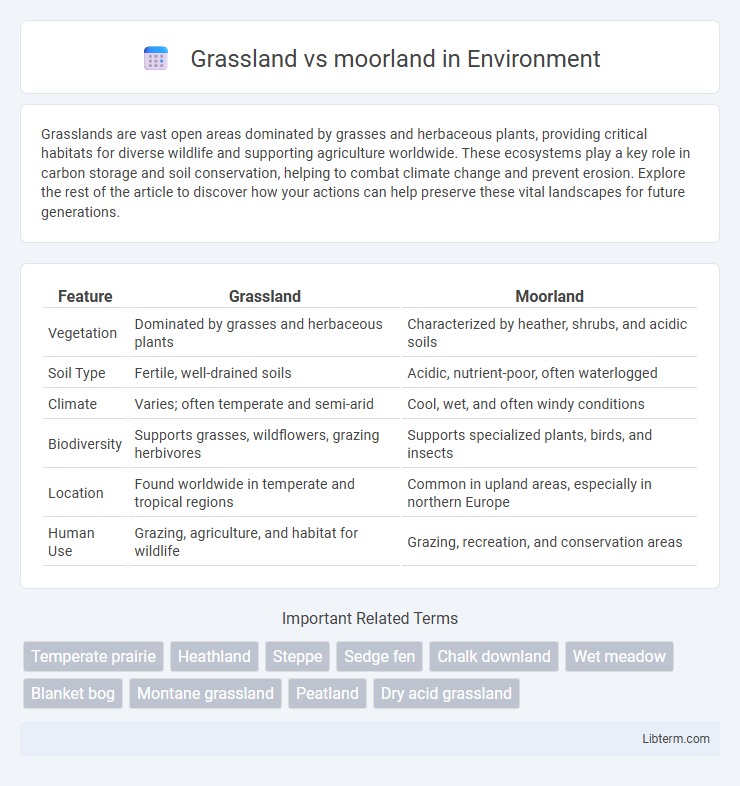Grasslands are vast open areas dominated by grasses and herbaceous plants, providing critical habitats for diverse wildlife and supporting agriculture worldwide. These ecosystems play a key role in carbon storage and soil conservation, helping to combat climate change and prevent erosion. Explore the rest of the article to discover how your actions can help preserve these vital landscapes for future generations.
Table of Comparison
| Feature | Grassland | Moorland |
|---|---|---|
| Vegetation | Dominated by grasses and herbaceous plants | Characterized by heather, shrubs, and acidic soils |
| Soil Type | Fertile, well-drained soils | Acidic, nutrient-poor, often waterlogged |
| Climate | Varies; often temperate and semi-arid | Cool, wet, and often windy conditions |
| Biodiversity | Supports grasses, wildflowers, grazing herbivores | Supports specialized plants, birds, and insects |
| Location | Found worldwide in temperate and tropical regions | Common in upland areas, especially in northern Europe |
| Human Use | Grazing, agriculture, and habitat for wildlife | Grazing, recreation, and conservation areas |
Introduction to Grassland and Moorland
Grasslands are extensive areas dominated by grasses and herbaceous plants, typically found in temperate and tropical regions with moderate rainfall. Moorlands consist of acid soil landscapes dominated by heather, mosses, and grasses, often located in upland areas with poor drainage and acidic conditions. Both ecosystems support unique biodiversity but differ significantly in vegetation composition and environmental conditions.
Defining Grassland Ecosystems
Grassland ecosystems are defined by dominant vegetation consisting mostly of grasses with fewer trees and shrubs, supporting diverse fauna including large herbivores and ground-nesting birds. These ecosystems maintain nutrient-rich soils and are crucial for carbon sequestration and water filtration. In contrast, moorlands typically feature acidic, nutrient-poor soils with heather and low shrubs, supporting specialized species adapted to harsher climatic conditions.
Key Features of Moorland
Moorland is characterized by acidic, nutrient-poor soils and is dominated by low-growing vegetation such as heather, mosses, and grasses adapted to wet, windy conditions. This habitat often features peat deposits and supports unique wildlife species including red grouse and certain hardy insects. Moorlands typically occur in upland areas with high rainfall and play a crucial role in carbon storage and water regulation.
Climate and Soil Differences
Grasslands typically develop in temperate or tropical climates with moderate rainfall and well-drained, fertile soils rich in organic matter. Moorlands are found in cooler, wetter climates, often characterized by acidic, nutrient-poor, and waterlogged soils with high peat content. These climatic and soil differences result in distinct vegetation: grasslands support dense grasses, while moorlands are dominated by heather and other hardy shrubs adapted to poor soil conditions.
Biodiversity: Flora and Fauna Comparison
Grasslands support a rich diversity of grasses, wildflowers, and herbivores such as bison and antelope, providing habitat for ground-nesting birds and insects essential for pollination. Moorlands are characterized by acid-tolerant plants like heather and cotton grass, sustaining specialized fauna including red grouse, mountain hares, and numerous invertebrates adapted to nutrient-poor soils. The contrast in soil pH, moisture, and vegetation structure drives distinct ecological communities, making each habitat crucial for regional biodiversity conservation.
Human Impact and Land Use
Grasslands and moorlands experience distinct human impacts and land use patterns, with grasslands primarily utilized for agriculture, livestock grazing, and urban development, leading to habitat fragmentation and soil degradation. Moorlands are often managed through controlled burning and grazing to support biodiversity and prevent scrub encroachment but face threats from peat extraction, afforestation, and recreational pressure. Both ecosystems are critical carbon sinks, and their alteration due to human activities significantly affects soil carbon storage and biodiversity conservation.
Ecological Importance and Functions
Grasslands support rich biodiversity by providing habitat for numerous herbivores, pollinators, and soil organisms, playing a crucial role in carbon sequestration and nutrient cycling. Moorlands, characterized by acidic soils and low-growing vegetation, act as significant carbon sinks and regulate water flow, preventing floods and maintaining water quality. Both ecosystems contribute to soil stabilization and offer essential ecosystem services that sustain regional biodiversity and climate regulation.
Management and Conservation Efforts
Grassland management emphasizes controlled grazing, periodic mowing, and invasive species removal to maintain plant diversity and prevent shrub encroachment while promoting soil health. Moorland conservation involves regulated burning, heather cutting, and water table management to preserve habitat heterogeneity and support rare species such as red grouse and sphagnum moss. Both ecosystems benefit from monitoring programs, community engagement, and adaptive strategies that respond to climate change impacts and human activities.
Threats to Grasslands and Moorlands
Grasslands face significant threats from agricultural expansion, overgrazing, and invasive species, leading to habitat fragmentation and loss of biodiversity. Moorlands are particularly vulnerable to burning practices, drainage for agriculture, and afforestation, which degrade soil quality and disrupt native plant communities. Climate change exacerbates these pressures on both ecosystems, altering precipitation patterns and increasing the frequency of extreme weather events.
Summary: Choosing Between Grassland and Moorland
Grassland ecosystems feature dense grasses and support high biodiversity with species adapted to open, sunny environments, making them ideal for grazing and agriculture. Moorlands are characterized by acidic, peaty soils with low-growing shrubs like heather, providing critical habitats for specialized wildlife and functioning as carbon sinks. Selecting between grassland and moorland depends on land use goals, soil type, and conservation priorities, balancing productivity with ecological preservation.
Grassland Infographic

 libterm.com
libterm.com